What Services Do I Need Running In System Configuration
Z7_3054ICK0KGTE30AQO5O3KA30N0
HP PCs - Using Microsoft Arrangement Configuration (Windows 10, 8)
This certificate is for HP and Compaq PCs with Windows 10 and Windows 8.
The Microsoft Organisation Configuration (msconfig) tool is a Microsoft software application used to change configuration settings, such as which software opens with Windows. Information technology contains several useful tabs: General, Boot, Services, Startup, and Tools. This document explains how you can use these tabs to resolve problems with your reckoner.
notation:For business computers, changes made using Microsoft Organisation Configuration might revert after reboot, or items might be unavailable or grayed out. These changes could be related to the management of the PC, where policies might exist set. Check with your company IT section or your local IT service for more than information.
Effigy : Organisation Configuration Window
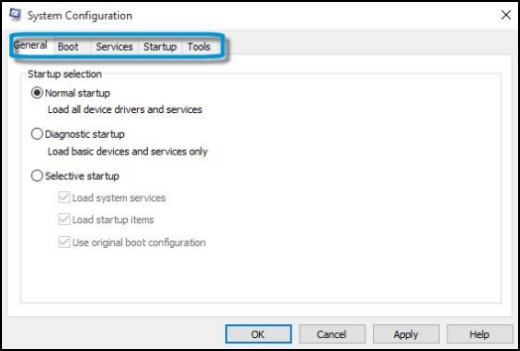
Opening msconfig to troubleshoot software issues in Windows ten and 8
In Windows, type msconfig into Search, and and so select System Configuration from the search results in Windows 10, or msconfig in Windows eight.
The System Configuration window opens.
General tab of the msconfig window
For troubleshooting purposes, in the general tab y'all can either prevent all nonessential software and services from loading or you can prevent individual programs from loading.
Preventing all nonessential software and services from loading
For troubleshooting purposes, use the following steps to prevent all software programs from automatically opening when Windows starts. This will increment usable memory and processor time.
circumspection:Use the following steps to prevent all startup items from opening, including antivirus software and other software that provides of import functions. Follow these steps for troubleshooting purposes only. If preventing all startup items from loading resolves the problem, yous can use the Startup tab (see post-obit section) to preclude an individual software item from loading.
-
Click the General tab.
-
Select Selective Startup, and deselect Load startup items.
Figure : Deselecting Load startup items
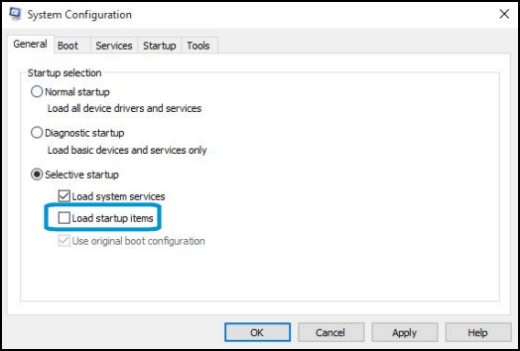
-
Click the Services tab.
Select Hide all Microsoft services, and then they volition not be disabled, and then click Disable all to disable the remaining items on the services tab.
Effigy : Services tab
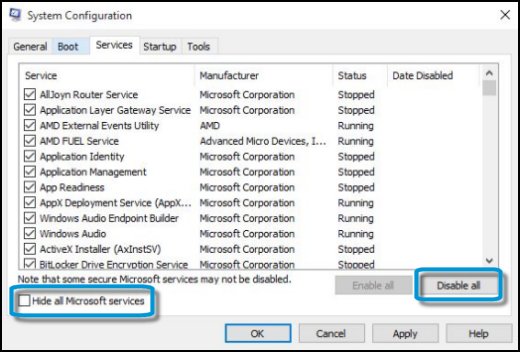
-
Restart the computer for the changes to take effect.
If you notice the problem no longer occurs afterward you prevent all software from loading, you tin apply the startup tab to try to detect the exact software title that is causing the problem. Select all simply ane title from the startup tab and restart. Continue doing this, deselecting software and restarting each time, until the problem no longer occurs. When y'all make up one's mind which software is causing the effect, uninstall it or forbid it from loading when Windows opens.
-
When y'all have finished using the Organization Configuration tool, open it once again and select Normal Startup and click OK.
Preventing private programs from loading
Utilise the General tab to preclude specific software applications from opening with Windows. The following selections are on the Full general tab:
-
Normal startup - instructs Windows to open all software applications that are commonly scheduled to start with Windows.
-
Diagnostic startup - starts Windows with basic services and drivers but. With this mode, you can determine if a basic Window file is the trouble.
-
Selective startup - allows y'all to choose which programs and services you want to open, and which you desire to keep from opening at startup tab.
Figure : Full general tab
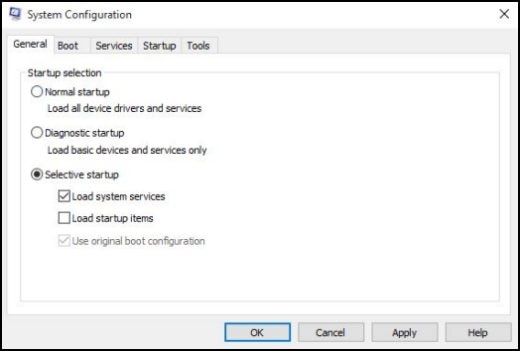
Boot tab of the msconfig window
The Boot tab is used to change the way Windows starts. The option in the boot tab show configuration options listed inside the system information file. Some options in the Boot tab are:
-
Safe kicking: Minimal - Disables networking. Boots to the Windows user interface (Explorer) in prophylactic style, running critical system services simply.
-
Safe boot: Alternate beat out - Disables networking. Boots to the control prompt in safe manner, running critical arrangement services only.
-
Safe boot: Active Directory repair - Like to minimal safe boot, except the Active Directory is enabled.
-
Rubber boot: Network - Similar to a minimal safe boot, except the network is enabled.
-
No GUI kick - The Windows splash screen is disabled when booting
-
Boot log - Stores all information from the boot process in a file.
-
Base video - Boots to Windows user interface in minimal VGA mode.
-
OS kicking information - Shows each commuter name as each driver is loaded during the boot process.
-
Make all boot settings permanent - Changes made in System Configuration are non tracked. If y'all want to make changes later, you will have to do then manually. Selecting Normal startup in the General tab does non work if this feature is selected.
-
Timeout field - Using Msconfig tin cause the operating system selection screen to display for thirty seconds; as a result, thirty seconds is added to the overall startup time. To prevent the operating selection screen from appearing for thirty seconds on startup, alter the timeout line in the Timeout field to zero.
Effigy : Kick tab
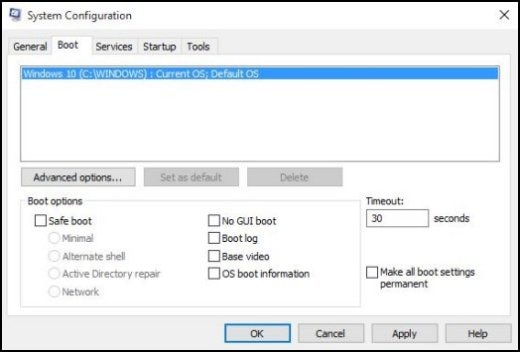
Services tab of the msconfig window
The Services tab lists integrated Windows services and programs that start when Windows 8 starts, or are run periodically by Windows. Be careful when disabling services as many are critical to the computer's performance. Enable or disable programs or services from starting by checking or disabling the checkbox next to the plan name.
Figure : Services tab

Startup tab of the msconfig window
On the Startup tab click Open Task Manager.
The startup table lists software that opens automatically when Windows loads. Use this tab to forestall individual software from opening when Windows starts. This can be very useful when trying to find a software program that might be causing functioning problems.
Figure : Startup tab
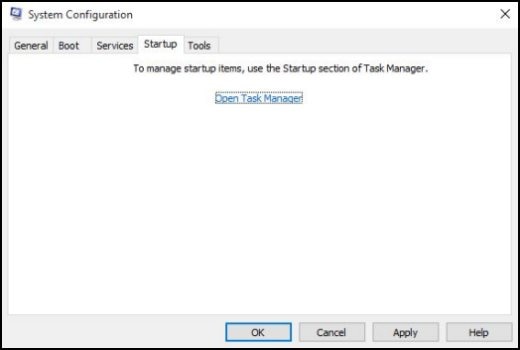
The following is a list of some of the types of software applications that open from the Job Manager:
-
Anti-virus software - Disable Anti-virus software just when troubleshooting. Make sure to enable the Anti-virus software when finished troubleshooting.
-
Keyboard managers - Disable to foreclose the extended multimedia keys and book command knob from working.
-
Systems tray icons - Disable to forbid a software awarding tray icon from displaying on the systems tray (side by side to the time).
The Startup tab of the Job Manager shows a list of current software applications that open automatically afterwards Windows opens and shows the condition of each program. Disable individual software applications by highlighting the awarding and clicking Disable.
Exercise non disable the following startup items except for diagnostic purposes only:
-
HD Audio Control Panel
-
HP KBD EXE
-
hp digital imaging - hp all-in-ane series
-
HPRun
-
hpsysdrv
-
HP Total Care Counselor
-
Microsoft Windows Operating System
-
NVIDIA products
-
Symantec Technologies products
Figure : Task Manager

Tools tab of the msconfig window
The Tools tab lists diagnostic tools and other advanced tools you tin can run to improve estimator performance. Before opening a tool, read the description adjacent to the name of the tool to better understand the function it provides. To open a tool, select the name of the tool from the listing and click Launch.
Figure : Tools tab
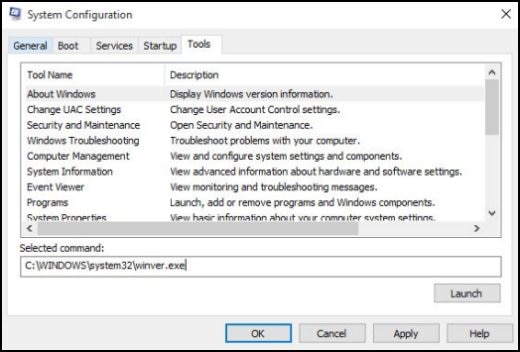
What Services Do I Need Running In System Configuration,
Source: https://support.hp.com/id-en/document/c03314799
Posted by: vossspaince56.blogspot.com


0 Response to "What Services Do I Need Running In System Configuration"
Post a Comment